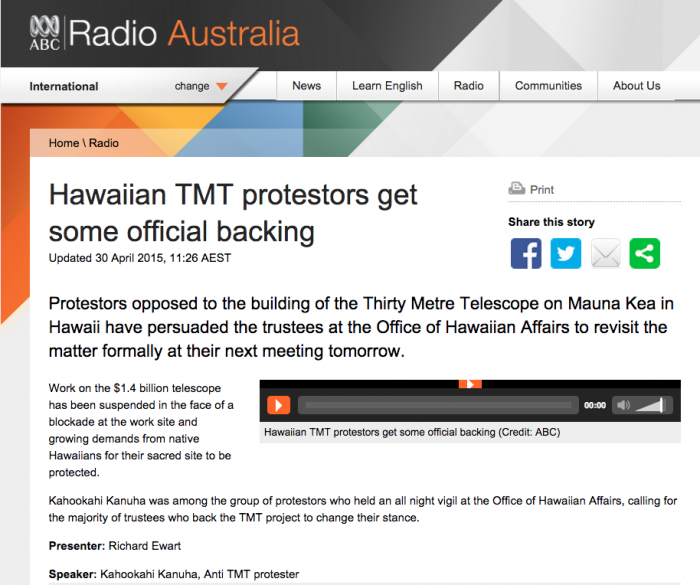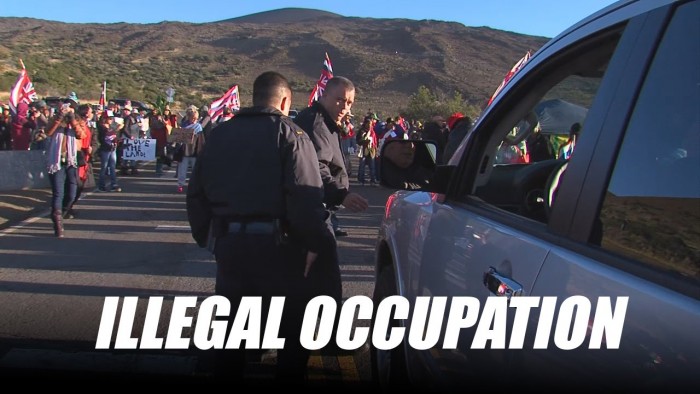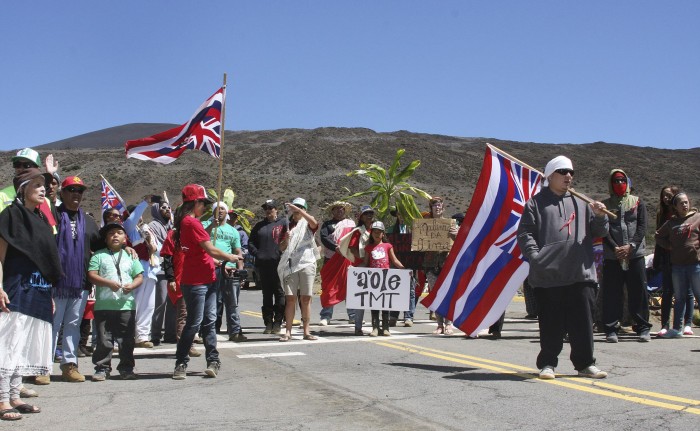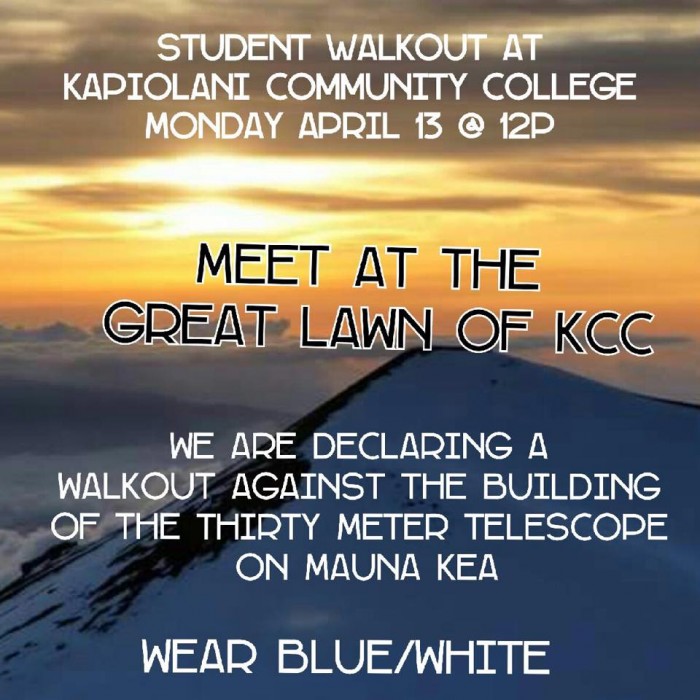Monthly Archives: April 2015
San Diego Free Press: Protecting Mauna Kea – History for Haoles

Will Faulk, a journalist for the San Diego Free Press, has consented to the reprint of his article that was published online today April 29, 2015.
In the first essay of my Protecting Mauna Kea series, I made a mistake. I wrongfully described the ongoing, illegal American occupation of Hawai’i as an “annexation.”
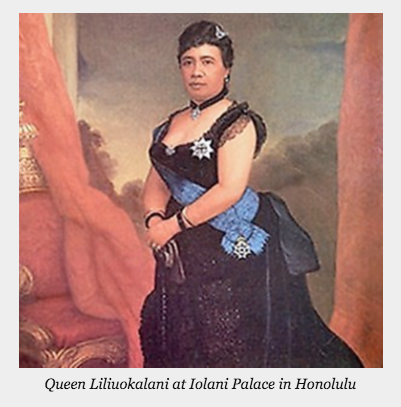
Hawaiian friends of mine pointed this out to me and gave me a thorough history lesson. I was referred to documents, books, and websites that tell the truth. For the last several days, I’ve been reading everything I can on the subject.
The more I read, the more convinced I become not only that the Thirty Meter Telescope project lacks any legal right to build on Mauna Kea, but that international law, indeed American law itself, demands that the United States end it’s occupation of Hawai’i.
I have two hopes for this piece. First, I want to give a history lesson for haoles. “Haole” is the Hawaiian word for white person. I am specifically directing this lesson at white settlers – at haoles – because the first thing haoles can do is understand the history of violence we benefit from.
This history lesson will demonstrate that the current regime controlling Hawai’i is illegitimate and as such has no authority to enforce the construction of the TMT on Mauna Kea.
Second, I want to relieve Hawaiians from the responsibility of educating haoles. Hawaiians have no responsibility to educate us. As a white settler hoping to stand in true solidarity with Hawaiians, I am upset with myself for the mistake. I have seen how frustrating it can be for a movement when valuable time must be spent coaching well-meaning settlers along.
I want to be clear: I am not advocating for a “call-out” culture on the front lines of resistance where resisters perpetually attack each other for their choice of words. Many of us must go through our personal experiences unlearning the lies we are taught and this takes time. The dominant culture, of course, does an excellent job lying. That’s why it’s the dominant culture.
But, I am saying that settlers need to take responsibility for educating other settlers. Leaving education to oppressed classes, forcing them to do the work of spreading consciousness, is a form of oppression in itself.
Before I begin, it is necessary to explain that this essay represents my opinions and my personal perspective of Hawaiian history stemming from the research I’ve done and been directed to. I am not a spokesperson for the Hawaiian people, neither am I spokesperson for the Mauna Kea protectors. I understand that there is no One True History, but I refuse to abide by the relativism I see perpetuating around me.
The complexity of a situation does not signify a lack of meaning. Rather, the complexity of a situation – especially ones with real, physical consequences – demands that we grapple with information to take a stand. As the world disintegrates before our eyes, I see too many people mired in the neutrality their belief in the relative nature of reality produces.
Make no mistake, if the construction of the TMT project results in the spill of hazardous chemicals in the largest freshwater aquifer on the Island of Hawai’i – a very real possibility – there will be very real consequences for life on the Island.
***
Milan Kundera famously stated the “struggle against oppression is the struggle of memory against forgetting.” I have found this to be shockingly true learning the history of Hawai’i. It is my belief that haoles have forgotten – or never knew – the history of Hawai’i. If we did not forget, there would be more of us supporting the Mauna Kea protectors and supporting true Hawaiian sovereignty.
What have we forgotten?
It starts centuries ago when Hawaiians first arrived in Hawai’i. Over the centuries, Hawaiians developed a culture based on ecological balance that included communal land tenure. I am very self-conscious that my attempts to explain a complex culture that existed for centuries before the arrival of Europeans would amount to so much generalization. I cannot possibly do the Hawaiian culture justice in a short essay, but so many discussions of Hawaiian history begin with the arrival of Captain Cook in 1778 erasing Hawaiian history pre-European contact.
There are always those that will accuse me of romanticizing Hawaiian culture, who will say “all human cultures are inherently destructive.” I do not mean to romanticize Hawaiian culture and it simply is not true that all human cultures are inherently destructive. We know the Hawaiian culture before 1778 had it’s own problems, but wide-scale ecological collapse was not one of them. In this era of total environmental destruction, we would do well to empower cultures who lived in balance with their land base.
From 1826 until 1893, the United States government recognized the independent Kingdom of Hawai’i including full, complete diplomatic relations with the Hawaiian government. For all intents and purposes, the United States viewed Hawai’i as a nation just like Mexico, Canada, or Great Britain. In fact, the United States entered into treaties involving navigation and commerce with Hawai’i in 1826, 1842, 1849, 1875, and 1887.

Then, in January, 1893, John L. Stevens, an American agent in Hawaii (his official title was United States Minister), conspired with non-Hawaiians and members of the U.S. Navy to overthrow the Hawaiian government. On January 16, 1893, Stevens and armed US naval personnel invaded Hawai’i and positioned themselves next to Hawaiian governmental buildings including Iolani Palace to intimidate Queen Liliuokalani. Queen Liliuokalani, under threats of bloodshed, yielded her authority to the government of the United States – NOT Stevens’ provisional government – until the time the United States would undo the actions of its representatives in Hawai’i.
Grover Cleveland was the president in 1893 and he initiated an investigation into the actions of Stevens and his cronies while calling for the restoration of the Hawaiian monarchy. The investigation concluded that Stevens and other US officials in Hawaii had abused their authority and had engaged in “an act of war.”
Still, the provisional government sought annexation in Congress, but was unable to rally the support of 2/3 of the Senate needed for annexation. So, on July 4, 1894, the provisional government that had forcibly invaded and overthrown the Kingdom of Hawai’i, declared itself the Republic of Hawai’i.
In 1896, William McKinley replaced Grover Cleveland as president. Using the excuse of the Spanish-American war and the need for a naval base in the Pacific, McKinley and the Senate began to entertain the notion of annexing Hawai’i, again.
In 1897, the Hawaiian people delivered a massive petition where nearly 90% of Hawaiians alive at the time declared their desire not to become part of the United States of America. Unable to secure a treaty of annexation, Congress passed a joint resolution titled “the Newlands Resolution” on July 7, 1898.
The illegality of this joint resolution is one of the most important things to understand about Hawaiian history. This resolution had no legal basis, had no validity, and was possible simply because of the armed might of the United States.
The resolution has no legitimate basis because laws passed by Congress have no authority internationally. Congress can only pass laws that apply within the United States.
Hawaiian legal scholar Dr. Keanu Sai explains it better than I can in his blog-article “International Law Prevents Construction of the Thirty Meter Telescope” when he writes, “The underlying problem that Congressmen at the time knew was that no law of Congress can have any force and effect beyond the borders of the United States. In other words, the United States could no more annex the Hawaiian Islands by passing a domestic law, than it could annex Canada today by passing a law.”
As part of the Newlands Resolution, the Republic of Hawai’i passed 1,800,000 acres of what had been crown, government, and public lands of the Kingdom of Hawai’i to the control of the United States. Included in this land is Mauna Kea. Through the acquisition of Mauna Kea in this way, the State of Hawai’i has leased land on Mauna Kea for the TMT’s construction. But, an illegal state giving land acquired illegally can only give – you guessed it – an illegal lease.
Of course, you don’t have to take my word for this history, because all of these facts were already admitted and apologized for by Congress on November 23, 1993. You can read their apology here.
***
So, can you see why we cannot call the occupation of Hawai’i an annexation? No treaty of annexation was ever signed. “Annexation” implies consent on the part of those annexed and clearly the Hawaiian people never consented.
To take this even deeper, the term “annexation” hides the truth, softens the reality that Hawai’i was invaded while the invaders still seek to assert dominance over Hawai’i. To use the term “annexation” is to forget and forgetting clears the wayfor oppression.
There’s something, though, that bothers me about all this. How can the American government and the American people after learning this history, after admitting the wrongs done to Hawai’i still allow something like the TMT project to happen? I think the answer is that learning the history is only the first small step. Knowing the history, we must act.
One of the intentions behind my writing is to try to understand how so many people can recognize problems in the world and then fail to act to solve those problems. I am a haole, so I can only speak as a haole, and I believe too many haoles settle for pointing out their privilege while the more important work involves undermining the forces that grants them that privilege over others in the first place. The history is clear. Hawaiians are being wronged. Now, we need to act.
U.S. Constitutional Law and Customary International Law for Territorial Annexation
To develop an informed position on current issues in Hawaiʻi, such as the TMT (Thirty Meter Telescope) standoff on Mauna Kea, it is important to have an accurate understanding of the legal status of Hawaiʻi.
The purpose of this article is to address common misconceptions people have regarding territorial annexation as it relates to the Constitution of the United States and customary international law.
www.archives.gov/exhibits/charters/constitution_transcript.html
In Article I, Section 8 of the U.S. Constitution, the enumerated powers of Congress are domestic. Specifically, there is no enumerated power for annexation of foreign territory.
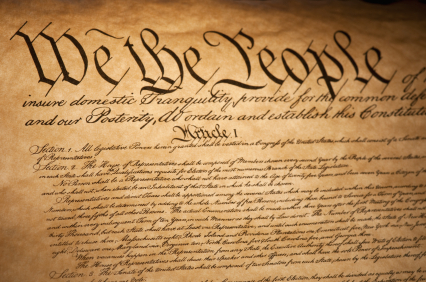
From Article II, Section 2 of the U.S. Constitution, regarding the President and Senate:
“He shall have Power, by and with the Advice and Consent of the Senate, to make Treaties, provided two thirds of the Senators present concur”
This power was used by the United States to enter 9 treaties of cession, annexing 56 out of 58 acquired territories, over a period of 168 years (1783-1951). This is the self-evident pattern of customary international law regarding territorial annexation, followed consistently by the United States throughout its history.
The Indian Appropriation Act of 1871 and the Island of Palmas arbitration in 1925 legally prevented this power from being used for annexation of American Sāmoa. There were two failed attempts, in 1893 and 1897, to use this power for annexation of Hawaiʻi, both of which were due to less than two thirds approval of the Senate.
The context of Article IV, Section 3, of the U.S. Constitution, is clearly domestic:
“New States may be admitted by the Congress into this Union; but no new State shall be formed or erected within the Jurisdiction of any other State; nor any State be formed by the Junction of two or more States, or Parts of States, without the Consent of the Legislatures of the States concerned as well as of the Congress.”
This power was used prematurely to admit Texas as a State in 1845 following two failed attempts, in 1837 and 1844, to pass a treaty of annexation for Texas in the U.S. Senate. The preliminary admission of Texas as a State in 1845 was followed by constitutional annexation of Texas as a Territory in 1848 through the Treaty of Guadalupe Hidalgo.
Therefore, since the Newlands Resolution claimed to annex Hawaiʻi as a Territory in 1898, and not admit it as a State, Texas is an invalid precedent. Furthermore, all 49 of the United States, including Texas, have a treaty of cession, while Hawaiʻi does not. This makes Hawaiʻi an unprecedented historical anomaly in violation of customary international law for territorial annexation, that in turn provides the evidence through which the U.S. constitution is interpreted.
88 out of 90 members of the U.S. Senate in 1898 opposed annexation of Hawaiʻi by joint resolution, because they held that it was unconstitutional in the context of customary international law, since Texas failed to provide a valid precedent. (youtu.be/yC4v0k0wd0Y)
The historical data for customary international law regarding territorial annexation, followed by the USA throughout its history, does not substantiate constitutional annexation of Hawaiʻi to the United States via joint resolution of U.S. Congress in 1898. This alleged annexation is an outlier in the data set—9 treaties annexing 56 territories in 168 years, plus the cession by American Sāmoa—that stands alone without precedent, both before and after the Newlands Resolution.
The provision in the U.S. Constitution for territorial annexation by a supermajority of the U.S. Senate is unequivocal when interpreted through this complete data set for customary international law. This is the appropriate context which must be included in any assessment of the claim of that Hawaiian sovereignty has been transferred to the United States.
Today, the typical American is oblivious to this complete data set regarding annexation of territory by the United States. However, this is not because access is restricted to these data, but due to generations of being indoctrinated by propaganda to the contrary. Therefore, instead of investigating the data, and interpeting it objectively, the typical American accepts the assumption that Hawaiʻi is the “50th State” as a foregone conclusion.
Hence, as will undoubtedly be demonstrated in comments on social media reacting to this article, Americans (and Americans-at-heart) will insist that Texas was annexed by joint resolution and not the Treaty of Guadalupe Hidalgo, since this underpins their belief that Hawaiʻi was annexed by joint resolution.
This unchallenged chain of assumptions, in turn, is a major factor underlying the belief that the TMT project has been legally approved for construction under American laws. However, by a score of 57 to 1, the data provided by customary international law fails to support the alternative hypothesis that the Hawaiian territory was annexed to the United States. In turn, these data invalidate the administration of U.S. laws in the Hawaiian territory.
Conversely, the data fails to reject the null hypothesis that the Hawaiian State has not been extinguished from its territory. Therefore, it cannot be concluded from customary international law that Hawaiʻi is part of the United States. Since occupation exists in the absence of annexation, and since both are mutually exclusive, the USA is in Hawaiʻi and not the other way around. In other words, Hawaiʻi is not part of the United States—nor has it ever been—without a treaty of cession.
Consequently, construction of the TMT would be classified as a war crime under international law through “extensive destruction and appropriation of property, not justified by military necessity and carried out unlawfully and wantonly,” which is one of the grave breaches specified in the 1949 Geneva Conventions.
Data Set & References: goo.gl/d6Ra2B
Author Bio
 Keokani Marciel is a lifelong aloha ʻāina (Hawaiian patriot) and kanaka ʻōiwi (aboriginal Hawaiian) who holds a B.S. in Nutrition Science from the University of California at Davis, and an M.S. in Exercise Science from California University of Pennsylvania. In 2008, Keokani made a career change to mathematics education, and is now beginning an actuarial career. With his background, he brings a quantitative and scientific outlook to the discourse regarding the legal status of Hawaiʻi as an occupied nation-state.
Keokani Marciel is a lifelong aloha ʻāina (Hawaiian patriot) and kanaka ʻōiwi (aboriginal Hawaiian) who holds a B.S. in Nutrition Science from the University of California at Davis, and an M.S. in Exercise Science from California University of Pennsylvania. In 2008, Keokani made a career change to mathematics education, and is now beginning an actuarial career. With his background, he brings a quantitative and scientific outlook to the discourse regarding the legal status of Hawaiʻi as an occupied nation-state.
Hawai‘i Law Professor Provides Clarity of Dispute on Mauna Kea to UH Board of Regents
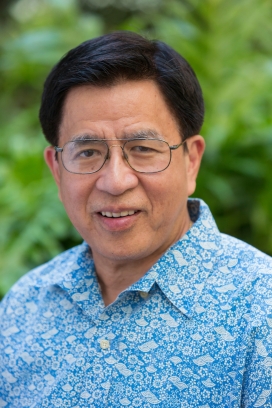 Testimony of Williamson B.C. Chang, Professor of Law, April 16, 2015 at a meeting of the University of Hawai‘i Board of Regents, University of Hawai‘i at Hilo.
Testimony of Williamson B.C. Chang, Professor of Law, April 16, 2015 at a meeting of the University of Hawai‘i Board of Regents, University of Hawai‘i at Hilo.
Honorable Board of Regents:
I have had the honor and pleasure to serve as a Professor of Law at the University of Hawai’i for the last 39 years. I have served the University and the community well. I am also grateful for the opportunity to serve and work in the University.
Let me start by saying this: I know a place, I know a country where there would never be a question whether to build an eighteen-story thirty meter telescope on the summit of Mauna Kea. That country, that nation is “Hawai’i.”
Before 1893, it would have been unthinkable that the Government of the Kingdom of Hawai’i would ever conceive of such a plan. Yes, Kalakaua loved astronomy. All Hawaiians loved the stars. However, they loved Mauna Kea even more. Mauna Kea is “sacred” it is the Sky-Father it is the essence, the beginning of the creation chant of the Hawaiian people. All Hawaiians, all Islands, even Taro are descendants of Mauna Kea.
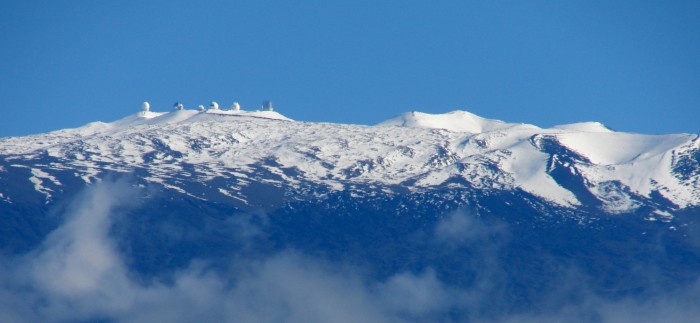
When I say “Mauna Kea” is sacred, I do not mean to use “sacred” the way most people use that term. I mean “sacred” not in the same sense of worship. I use “sacred” in the sense of “precious” and “so important that nothing else counts”—I apply it to those things and people that we care so much about that we would do anything, even flout and break the law, to preserve their existence.
The child of a parent, especially a young child is “sacred” in this sense. So are parents to their children. So are grandparents. Even the family pet is “sacred.” If your house was burning down would you risk your life to go into the burning house to rescue your children, your mother, your grandparents, even your beloved dog or cat? Would you go even if forbidden by first responders, firemen or policemen? Yes, many of us would go without hesitation–without thinking of the consequences. Would you give a kidney to save or extend the life of your child, your brother, your uncle? Would you spend all of your money to save a loved one from cancer? from Lou Gehrig’s disease or from a life in prison without parole? Yes, we all would.
Moreover, we praise such emotions and desires of others who make such sacrifices every day. We understand the soldier who sacrifices himself by instinctively jumping on a grenade. We understand the parent or grandparent who gives all their money to see their child or grandchild through college.
Whether one worships Mauna Kea or not, whether one considers it “sacred” does not matter as much as understanding the instincts that drive those to defend and save Mauna Kea—much as one would understand the absolute love for a child, or a parent even if such acts break the law.
When we see the instinct of family, of brotherhood, of sisterhood of love for mankind in others we celebrate that—we gravitate to that. We love and defend Mauna Kea because it reminds us what makes us human. Sacred is not necessarily a place. It is a relationship, a deep visceral relationship: beyond reason, beyond law, beyond rationality.
The Mauna Kea movement is a movement that has grown because of young people. They live in new confusing world themselves—a world of cognitive dissonance. That is they live within an outright contraction—a Hawaii in decline where there is nothing they can do. They see their world being attacked and destroyed, its water taken, its plants doused with foreign chemicals, its agricultural lands disappear in the name of gentlemen farmers, its open lands used for artillery practice, and its shoreline becoming high-end condominiums that only rich foreigners can afford.

Moreover, to the young, Hawaii is unlivable, there is no viable future: There are no places to rent, no jobs that fit their training, no money for retirement and the endless, life-sapping traffic congestion. And now an eighteen story telescope on Mauna Kea!

It would never be built on other sacred sites: not over the Western Wall, the Dome of the Rock, Angor Wat, Gettysburg, Arlington, or the Arizona Memorial? No one would think of putting a pair of glasses on the eyes of God. Why then, Mauna Kea? We, and our youth are inundated today with the attacks on the treasures of the earth and why?
So, what happened to this “nation” called Hawai‘i, where Mauna Kea was loved and adored? Hawai‘i was a nation, that by a series of events, starting with an overthrow in 1893 and ending with annexation in 1900, by which another nation, the United States, forcefully took the sovereignty of Hawai‘i.
What do I mean by that?—to take one nation’s sovereignty? Sovereignty is the monopoly of a government on the legitimate use of violence.
By that I mean the State, the police and DLNR are the only ones today who can do so-called “legal” violence to Mauna Kea. Similarly, the police of Hawai‘i County and the officers DLNR are the only ones who can use the violence of arrest and jail or fine to force down the protectors of Mauna Kea. Protect the mountain and you go to jail. It is legal. It is called law. It is a power possessed only by the sovereign of a nation. There once was a time in Hawaii when that monopoly on the use of legal power protected not defiled Mauna Kea.
In 1893 and 1900 a new Nation took over in Hawai‘i—a new nation with new rules. These were new rules that had the power to interfere with our very human, emotions and instincts, instincts derived over time from our kupuna, our ancestors and the culture of this nation of Hawai‘i. Hawai‘i has changed.
Today, government has the legitimate power to do violence to families as well. Government agencies can take a child away from a parent. Government agencies can put a Hawaiian in prison for the smallest of offenses—denying him or her freedom and the chance to be with and raise their families. The world of Hawai‘i has been turned upside down.
The answer lies in power, that is law—the shift over their lives by which all is reversed.
In 1898 the United States, by Joint Resolution took the nation of Hawai‘i. I am a legal historian. In the appendix attached I show my work—that concludes definitively that the joint resolution had no such power. It was impotent, it was an act of Congress not a treaty. It could no more take Hawai‘i by a law then Hawai‘i by a law could take America.
It was a fraud—it created a disease that spread, a malaise we all suffer—called the myth of annexation. We all believe we are part of America, we all act as if that were true. We have been taught that way. We follow the lead of others who act that way.
The truth is that the joint resolution did not give to the United States the monopoly on the use of legitimate violence—a violence to build on Mauna Kea, the violence to arrest those who seek to stop that building. Most of all the University claims Mauna Kea by lease—a lease derived from the Joint Resolution.
It is said that the Joint Resolution gave Mauna Kea to the United States, which gave it to the State, which gave it to the University. As a matter of law that is false. It is a lie. The University has no power over Mauna Kea. It cannot build, it cannot give permits, it cannot arrest us.
The mass of young people are here today in protest because we live in a world of cognitive dissonance. They live in a world where they are learning, at the University about the truth of the Joint Resolution, which gives no power, no sovereignty to the state. Outside of their classes they see the State taking what they love—preventing them from running into the burning house to save their Mauna Kea, their father, their sky-father.
And this dissonance makes them ill. It makes our youth sick. It is a crisis that creates mental illness. In short, to build on Mauna Kea is to cast a sickness throughout these islands, a sickness and sadness, not only on Native Hawaiians but on all people who live here.
I have included an appendix, taken from my work, which speaks to the myth of annexation and demonstrates that the Joint Resolution had no capacity to take the Nation of Hawai‘i. I will place this testimony and my appendix on my “Scholar Space” at Hamilton Library, the University of Hawai‘i at Manoa, under my name. This is the link to that site.
Mahalo and Mahalo Ke Akua.
Williamson Chang
Professor of Law
Reputable Swiss Newspaper NZZ Breaks Story on War Crimes in Hawai‘i
In its Sunday edition (April 19, 2015) on page 12, Neue Zürcher Zeitung (NZZ) a Swiss German language daily newspaper published in Zurich, broke the story of war crimes committed by the United States in Hawai‘i. NZZ has a reputation as a quality newspaper and as the Swiss newspaper of record, the newspaper is known for its detailed reports on international affairs, stock exchange, and the intellectual, in-depth style of its articles. Here is the English translation of the article.
Click here to download the article in NZZ Sunday newspaper.

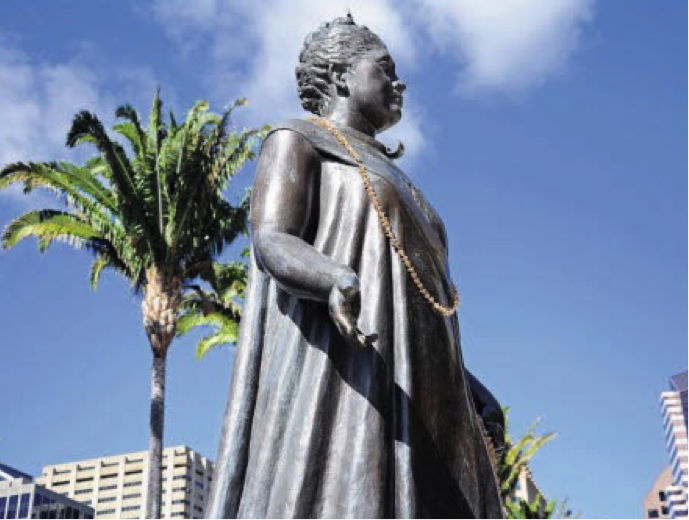 The authorities of the Federal Judiciary are confronted with a strange case, which has the potential of straining the relations between Switzerland and the USA. What is to be clarified is nothing less than the question of whether in the view of the [Swiss] Confederation Hawaii is recognized in accordance with international law as the 50th Federal State of the USA, or whether the Kingdom of Hawaii rather still exists – albeit since 1898 under occupation. Furthermore, it is to be determined whether the USA committed war crimes in Hawaii, including against Swiss residing there – and this possibly even with the assistance of the Swiss Joe Ackermann. It is indeed a delicate dossier, which since April 9 has been with the Federal Criminal Court in Bellinzona.
The authorities of the Federal Judiciary are confronted with a strange case, which has the potential of straining the relations between Switzerland and the USA. What is to be clarified is nothing less than the question of whether in the view of the [Swiss] Confederation Hawaii is recognized in accordance with international law as the 50th Federal State of the USA, or whether the Kingdom of Hawaii rather still exists – albeit since 1898 under occupation. Furthermore, it is to be determined whether the USA committed war crimes in Hawaii, including against Swiss residing there – and this possibly even with the assistance of the Swiss Joe Ackermann. It is indeed a delicate dossier, which since April 9 has been with the Federal Criminal Court in Bellinzona.
Coup against Lili‘uokalani
Specifically, the case is about the criminal complaints by a Swiss and a “Hawaiian Subject,” as the latter identifies himself in the documents. In petitions to the Office of the Swiss Federal Attorney General dating from January, these two accuse the US authorities of war crimes, including pillaging, unfair trials and unlawful detention. These are said to have taken place in the context of financial disputes in Hawaii – disputes which, however, are directly related to the question of Hawaii’s status in international law: Both plaintiffs hold the view that the Kingdom of Hawaii still exists, and that in consequence, the US authorities have no rights whatsoever in the archipelago. The Swiss, who by virtue of his nationality considers the Office of the Federal Attorney General to have jurisdiction in this case, is bringing action for unlawful appropriation of property as well as pillaging in form of taxation by the US tax authorities. The Hawaiian subject, on the other hand, sees himself as being cheated when purchasing a real property: The transaction at first followed US-American law and was notarized accordingly. But then the subject came to the conclusion that the USA was not authorized to do such official acts on the territory of the occupied Kingdom of Hawaii – in consequence he discontinued his interest payments to the lending bank.
Joe Ackermann As former CEO of Deutsche Bank, the Swiss business leader was targeted by Hawaiian subjects As former CEO of Deutsche Bank, the Swiss business leader was targeted by Hawaiian subjects |
The bank in question was Deutsche Bank, which ordered the mortgaged property to be foreclosed, by US authorities of course. In this context the subject was temporarily arrested. At that time, Joe Ackermann was heading Deutsche Bank – a sufficient reason for the Hawaiian to make a criminal complaint against the Swiss banker to the Office of the Federal Attorney General in Berne. So much on the specific cases.
The matter might be dismissed as a legal frivolity by two odd characters, were it not for a larger movement standing behind it, a movement which has seriously been addressing the question of the continuity of the Kingdom of Hawaii for years. The prime mover is Keanu Sai, “a political scientist whose research and expertise centers on the continuity of the Hawaiian Kingdom as an independent and sovereign State,” as he states.
At the center of the debate are historical events: In 1893, the last Queen of Hawaii, Lili‘uokalani, was deposed in a coup d’état and in 1895 forced to abdicate (see box). Goal of the coup leaders – protected by US troops – was the annexation of Hawaii by the USA. The latter happened, effectively, in 1898, in connection with the Spanish-American war, when Hawaii gained strategic importance in the Pacific. The USA employed as a basis for the occupation a so-called “joint resolution,” a legal act jointly passed in the Senate and the Congress [sic] in Washington. The admittance to the United States as the 50th State happened only in 1959, after a plebiscite with a clear-cut result – by then, of course, the culture of the Hawaiian people had already been pushed back strongly by American and Asian immigrants.
For Sai and his colleagues, the unilateral American decisions are all null and void. A “joint resolution” of the legislature in Washington, such as the one of 1898, could be legally effective according to constitutional law only within the USA and could not be extended to another territory, such as the Kingdom of Hawaii. The Federal State of Hawaii of today, therefore, is seen as a direct successor to the Republic of Hawaii that was proclaimed by the coup leaders in the 1890s. Thus, it would have no legitimacy whatsoever under international law. Sai has placed his struggle for the Kingdom of Hawaii into courtrooms all over the world, including in Switzerland. Here he is now representing the two plaintiffs. His argument includes a friendship treaty between the [Swiss] Confederation and the Kingdom of Hawaii from 1864: The Treaty is said to have been never officially cancelled or replaced with another convention. The treaty obliges both parties to protect each other’s citizens – thus, it is argued, the Office of the Federal Attorney General must now prosecute the alleged war crimes of the USA in Hawaii.
Diplomatic Help
In Berne, sure enough, the situation is assessed differently: Pointing to the factual recognition of the USA in its present boundaries by the [Swiss] Federal Government, the prosecutor in charge decided not to accept the complaint. Berne, he argued, has no jurisdiction in the case. He included reference to the fact that Switzerland maintains a consulate in Hawaii – which is not without irony since, of all things, it is a long-serving diplomat who today is acting as a door-opener for Sai in Switzerland.
The dismissive decision of the Federal Attorney General’s Office was indeed unable to stop the Hawaiian independence fighter Sai: The latter appealed the decision – now the case is up to the judges in Bellinzona.
Swiss Federal Criminal Court Hears Case on War Crimes Committed by United States in Hawai‘i
PRESS RELEASE
FOR IMMEDIATE RELEASE
April 19, 2015
Swiss Federal Criminal Court to Hear Objection on War Crimes Committed by United States Officials and Deutsche Bank in the Hawaiian Islands
HONOLULU—A Swiss citizen and a Hawaiian subject from the Hawaiian Kingdom filed an objection with the Swiss Federal Criminal Court Objections Chamber in Bellinzona, Canton of Ticino, on April 1, 2015. The identity of the Hawaiian subject is Mr. Kale Kepekaio Gumapac, but the identity of the Swiss citizen is being kept confidential for safety reasons. Both appellants are residents of the Hawaiian Islands and are represented in these proceedings by Dr. David Keanu Sai through powers of attorney. Dr. Sai is a political scientist whose research and expertise centers on the continuity of the Hawaiian Kingdom as an independent and sovereign State.
“During the Spanish-American War in 1898, the United States has belligerently occupied the Hawaiian Kingdom being a neutral State,” says Dr. Sai. “As a result of the prolonged occupation of a neutral country, the United States is responsible for the commission of war crimes that have been committed for over a century on a monumental scale. The war crimes committed against the two appellants include pillaging, unfair trial, unlawful confinement and unlawful appropriation of property.”
The initial war crime complaint was filed with the Swiss Attorney General’s office in Bern on December 22, 2014 by Gumapac alleging war crimes have been committed against himself by Deutsche Bank for the pillaging of his home, whose Chief Executive Officer at the time was a Swiss citizen and resident of Zurich. Deutsche Bank’s pillaging of Gumapac’s home was carried out by State of Hawai‘i Deputy Sheriff Lieutenant Patrick Kawai, which also led to his unlawful arrest.
Click here to download war crimes report. The exhibits for Mr. Kale Gumapac identified in the war crimes report can be downloaded here: Exhibit #1, Exhibit #2, Exhibit #3, Exhibit #4, Exhibit #5, Exhibit #6, Exhibit #7, Exhibit #8, Exhibit #9-A, Exhibit #9-B, Exhibit #9-C.
The second complaint was filed with the Attorney General’s office on January 22, 2015 by the unnamed Swiss citizen alleging the war crimes of pillaging and unlawful appropriation of property under the guise of taxation that were committed against himself between 2006 and 2013 by the self-declared State of Hawai‘i and the United States Internal Revenue Service (IRS).
“The State of Hawai‘i has no lawful authority in the Hawaiian Islands because Congress created it by a Congressional law in 1959, which has no effect outside of U.S. territory.” said Dr. Sai. “It is also a direct successor of the provisional government of 1893 and the so-called Republic of Hawai‘i of 1894, both of which the United States determined were self-declared. So a self-declared entity is not a government that can lawfully tax people, and the IRS can only tax their own citizens who reside in a foreign country. It can’t tax the entire population of a foreign country. This is a war crime.”
The complaints were given criminal case number SV.15.0101-MUA and assigned to Federal Prosecutor Andreas Muller of the Center of Competence of International Crimes, an agency of the Office of the Attorney General that is empowered to prosecute war crimes.
Prosecutor Muller officially notified Dr. Sai in a letter dated February 3, 2015 that he completed his criminal investigation into the alleged war crimes and concluded there are no war crimes being committed in the Hawaiian Islands. Dr. Sai received the report (German) (English translation) on March 23, 2015. Both the Prosecutor’s notification and the report were in the German language. Prosecutor Muller stated to Dr. Sai that his decision could be appealed to the Swiss Criminal Court Objections Chamber within 10 days after receiving the report.
In his report, Prosecutor Muller specifically cites the 1898 Congressional joint resolution of annexation as the means by which the Hawaiian Islands was annexed. He also stated that there was an agreement of annexation between the United States and the self-declared Republic of Hawai‘i. Prosecutor Muller further stated that Congress created the State of Hawai‘i in 1959 and that Switzerland officially recognizes that Hawai‘i is a part of the United States and maintains a Consulate in Honolulu.
However, according to Dr. Sai, there is a clear contradiction in the Prosecutor’s report. In the beginning of the report, Prosecutor Muller stated that Hawai‘i was officially recognized as being a part of the United States, but later he stated that the 1864 treaty between the Hawaiian Kingdom and the Swiss Confederation was not cancelled. Article 13 of the treaty states that in order to terminate the treaty, either the Swiss government or the Hawaiian Kingdom government must notify the other in writing of its intention to terminate. There is no record that the Swiss government or the Hawaiian government provided any notice of termination.
“A treaty is a contract between States and in this case it is a contract between the Swiss State and the Hawaiian State,” said Dr. Sai. “A treaty is not a contract between governments because governments represent States and are not the States themselves. Should a government be illegally overthrown, as is the case for Hawai‘i, the contracting State, being the Hawaiian Kingdom, would still exist and therefore the treaty would still be in effect. When the Japanese and German governments were overthrown at the end of World War II, their treaties with other countries were not cancelled.”
Another way a treaty could be canceled under international law is where one of the contracting States ceded its sovereignty to another State by a treaty. This absorption of one of the contracting States into another State would have effectively replaced the former treaty with the treaty the absorbing State would have with the other contracting State. In other words, if the Hawaiian Kingdom were annexed by the United States under international law, then the United States-Swiss treaty would have replaced and therefore cancelled the Hawaiian-Swiss treaty. This is what occurred to the 1848 Hawaiian-Hamburg treaty and the 1854 Hawaiian-Bremen treaty when both of these States joined the German Empire in 1871. Both treaties were cancelled when Germany entered into a treaty with the Hawaiian Kingdom in 1879.
Dr. Sai said, “If the Prosecutor was convinced that a domestic law of the American Congress could annex a foreign State and terminate its existence under international law, he wouldn’t conclude in an official report that the Hawaiian-Swiss Treaty was not cancelled. He would have stated that the Hawaiian-Swiss treaty was cancelled and replaced by the United States-Swiss treaty. That was clearly not the case.”
Dr. Sai, who is a political scientist that specializes in international relations, said that it is proper diplomatic etiquette that governments must presume that other countries would not violate international law. This presumption, though, is rebuttable if there is convincing evidence that the country has violated international law. “So the Swiss government probably approached the American Embassy in the city of Bern and asked the United States how did it annex the Hawaiian Islands,” stated Dr. Sai. “And when the American government said they passed a law in Congress to annex Hawai‘i, the Swiss government would have to take it at face value and assume that under American law, Congress has the ability to annex a foreign country.”
Since Dr. Sai received the official report by the prosecutor on March 23, Swiss law would allow the objection to be mailed from Hawai‘i no later than April 2. FedEx received the appeal in Honolulu on April 1 from Dr. Sai, and on April 8 it was delivered to the Swiss Criminal Court Objections Chamber in the city of Bellinzona, Canton of Ticino. Dr. Sai received confirmation that the court is in receipt of the objection and the case has been assigned reference no. BB.2015.36-37 (German) (English translation).
In a letter (German) (English translation) dated April 9, 2015, the Clerk of the Federal Criminal Court notified the Federal Prosecutor that the court is in receipt of the objection and has requested the Prosecutor to furnish the Federal Criminal Court right away with the records in this matter with an index of the records.
“The appeal to the Swiss Criminal Court Objections Chamber is the perfect forum to provide the rebuttable evidence that the United States has violated international law,” said Dr. Sai. “Our appeal centers on four points: first, United States Congressional laws are not a source of international law and therefore cannot annex a foreign country; second, there is no agreement between the United States and the self-declared Republic of Hawai‘i; third, Switzerland acknowledges the continuity of the Hawaiian Kingdom as contracting State in the Hawaiian Swiss-Treaty; and, fourth, the United States cannot deny the existence of the Hawaiian Kingdom because a criminal court of the so-called State of Hawai‘i recognized the existence of the Hawaiian Kingdom by a ruling on evidence on March 5, 2015.”
###
CONTACT: Dr. David Keanu Sai
Phone: (808) 383-6100
Email: keanu.sai@gmail.com
War Crimes: TMT Told to Cease and Desist
On April 17, 2015 the following cease and desist letter was sent by Dexter Kaiama, legal counsel for Chase Kaho‘okahi Kanuha and Lanakila Mangauil, to Douglas Ing from the law firm Watanabe and Ing who is the legal counsel for TMT International Observatory, LLC. Kanuha and Mangauil are the leaders of the protectors of Mauna Kea.
The cease and desist letter was also sent to the Canadian Department of Justice, who investigates war crimes, the Prosecutor the International Criminal Court, the Board of Regent of the University of Hawai‘i, the State of Hawai‘i Board of Land and Natural Resources, the Trustees of the Office of Hawaiian Affairs, County of Hawai‘i Police Department.
******
TMT International Observatory, LLC,
by its attorney James Douglas Ing
First Hawaiian Center
999 Bishop Street, 23rd Floor
Honolulu, HI 96813
Re: WAR CRIMES CEASE & DESIST NOTIFICATION- Construction of 30-Meter Telescope on Mauna Kea
Dear Mr. Ing:
This law office represents Chase Kaho‘okahi Kanuha and Lanakila Mangauil, both being Hawaiian subjects of the Hawaiian Kingdom with vested undivided rights in the lands as native tenants under Hawaiian law.
Your client, TMT International Observatory, LLC, is hereby directed to immediately cease and desist in the construction of a 30-meter telescope on the summit of Mauna Kea that is situated within the ahupua‘a of Ka‘ohe, district of Hamakua, Island of Hawai‘i, Hawaiian Kingdom. The ahupua‘a of Ka‘ohe is public land under the administration of the Minister of the Interior of the Hawaiian Kingdom under An Act Relating to the Lands of His Majesty the King and of the Government (1848). The Hawaiian Kingdom has been under an illegal and prolonged occupation by the United States of America since August 12, 1898 during the Spanish-American War.
Under international law, extensive destruction and appropriation of property not justified by military necessity and carried out unlawfully and wantonly is a war crime. The construction of permanent fixtures on public property that belongs to the Hawaiian Kingdom government is extensive destruction of that property.
On behalf of my clients, be advised that the construction of the 30-meter telescope is a war crime in violation of:
- Article 56, Hague Convention, IV (1907), “All seizure of, destruction or willful damage done to institutions [dedicated to religion, charity and education, the arts and sciences, even when State property], historic monuments, works of art and science, is forbidden, and should be made the subject of legal proceedings;”
- Article 53, Geneva Convention, IV (1949), “Any destruction by the Occupying Power of real or personal property belonging individually or collectively to private persons, or to the State, or other public authorities, or to social or co-operative organizations, is prohibited, except where such destruction is rendered absolutely necessary by military operations;” and
- Article 147, Geneva Convention, IV (1949), “Grave breaches… shall be those involving any of the following acts, if committed against persons or property protected by the present Convention: …extensive destruction and appropriation of property, not justified by military necessity and carried out unlawfully and wantonly.”
The United States military’s omission of preventing the destruction of the public property of the Hawaiian Kingdom is also a war crime in violation of:
- Article 55, Hague Convention, IV (1907), “The occupying State shall be regarded only as administrator and usufructuary of public buildings, real estate, forests, and agricultural estates belonging to the [occupied] State, and situated in the occupied country. It must safeguard the capital of these properties, and administer them in accordance with the rules of usufruct.”
The Final Declaration adopted by the International Conference for the Protection of War Victims in 1993 urged all States to make every effort to, “Reaffirm and ensure respect for the rules of international humanitarian law applicable during armed conflicts protecting…the natural environment…against wanton destruction causing serious environmental damage.” In its advisory opinion in the Nuclear Weapons case in 1996, the International Court of Justice stated, “States must take environmental considerations into account when assessing what is necessary and proportionate… Respect for the environment is one of the elements that go to assessing whether an action is in conformity with the principle of necessity.”
War crimes of destruction of real property on the summit of Mauna Kea belonging to the occupied State have been committed since the State of Hawai‘i leased 13,321.054 acres of the summit of Mauna Kea to the University of Hawai‘i in 1968. Thirteen telescopes have been constructed as permanent fixtures since 1970, and your client will make it fourteen. TMT International Observatory, LLC, has already committed the war crime of destruction of property when it began the construction of the 30-meter telescope by breaking ground, and has committed secondary war crimes of unlawful confinement (Article 147, Geneva Convention, IV) when 31 individuals who were preventing TMT International Observatory, LLC, from committing additional destruction.
The Hawaiian Islands was never an incorporated territory of the United States and is currently under an illegal and prolonged occupation. The Hawaiian Kingdom was recognized as an independent and sovereign State since November 28, 1843 by joint proclamation of Great Britain and France. As a result of the United States’ recognition of Hawaiian independence, the Hawaiian Kingdom entered into a Treaty of Friendship, Commerce and Navigation, Dec. 20th 1849 (9 U.S. Stat. 977); Treaty of Commercial Reciprocity, Jan. 13th 1875 (19 U.S. Stat. 625); Postal Convention Concerning Money Orders, Sep. 11th 1883 (23 U.S. Stat. 736); and a Supplementary Convention to the 1875 Treaty of Commercial Reciprocity, Dec. 6th 1884 (25 U.S. Stat. 1399).
The Hawaiian Kingdom also entered into treaties with Austria-Hungary, June 18, 1875; Belgium, Oct. 4, 1862; Bremen, March 27, 1854; Denmark, Oct. 19th 1846; France, July 17, 1839, March 26, 1846, Sep. 8, 1858; French Tahiti, Nov. 24, 1853; Germany, March 25, 1879; Great Britain, Nov. 13, 1836 and March 26, 1846; Great Britain’s New South Wales, March 10, 1874; Hamburg, Jan. 8, 1848; Italy, July 22, 1863; Japan, Aug. 19, 1871, Jan. 28, 1886; Netherlands, Oct. 16, 1862; Luxembourg, Oct. 16, 1862; Portugal, May 5, 1882; Russia, June 19, 1869; Samoa, March 20, 1887; Spain, Oct. 9, 1863; Sweden-Norway, April 5, 1855; and Switzerland, July 20, 1864.
Unable to procure a treaty of cession from the Hawaiian Kingdom government acquiring the Hawaiian Islands as required by international law, Congress enacted a Joint Resolution To provide for annexing the Hawaiian Islands to the United States, which was signed into law by President McKinley on July 7, 1898 during the Spanish-American War (30 U.S. Stat. 750) as a war measure. Congressional laws have no extraterritorial effect and are confined to United States territory.
The Hawaiian Kingdom came under military occupation on August 12, 1898 at the height of the Spanish-American War in order to reinforce and supply troops that have been occupying the Spanish colonies of Guam and the Philippines since May 1, 1898. Following the close of the Spanish-American War by the Treaty of Paris signed December 10, 1898 (30 U.S. Stat. 1754), U.S. troops remained in the Hawaiian Islands and continued its occupation to date in violation of international law.
U.S. War Department General Orders no. 101 (July 18, 1898) regulated U.S. troops when it began the occupation of the Hawaiian Islands on August 12, 1898. General Orders no. 101 mandated the Commander of U.S. troops to administer the laws of the occupied territory, being the civil and penal laws of the Hawaiian Kingdom. This order was not complied with. Administration of the laws of the occupied State was codified by Article 43, 1899 Hague Convention, II (32 U.S. Stat. 1803), and then superseded by Article 43, 1907 Hague Convention, IV (36 U.S. Stat. 2227). On August 12, 1949, the United States signed and ratified the (IV) Geneva Convention Relative to the Protection of Civilian Persons in Time of War of 12 August 1949 (6 U.S.T. 3516, T.I.A.S No. 3365, 75 U.N.T.S. 287).
In direct violation of the 1899 Hague Convention, II, President McKinley signed into United States law An Act To provide a government for the Territory of Hawai‘i on April 30, 1900 (31 U.S. Stat. 141); and on March 18, 1959, President Eisenhower signed into United States law An Act To provide for the admission of the State of Hawai‘i into the Union (73 U.S. Stat. 4) in direct violation of the 1907 Hague Convention, IV. These domestic laws have no extraterritorial effect and stand in direct violation of the 1907 Hague Convention, IV, the 1949 Geneva Convention Relative to the Protection of Civilian Persons in Time of War, IV, international humanitarian law, and customary international law—jus cogens.
In an evidentiary ruling in State of Hawai‘i v. English (CR 14-1-0820) on March 5, 2015, where I served as defense counsel, the State of Hawai‘i Circuit Court took judicial notice of adjudicative facts that concluded the Hawaiian Kingdom continues to exist as a State under international law, despite the illegal overthrow of its government by the United States of America on January 17, 1893 and the prolonged occupation since August 12, 1898. This ruling reaffirms the illegitimacy of the State of Hawai‘i and therefore its claim to be a de jure government is unfounded. State of Hawai‘i officials are also named in a pending criminal investigation for war crimes that is currently before the Swiss Federal Criminal Court Appeals Chamber under Gumapac, et al., vs. Office of the Federal Attorney General, reference no. BB.2015.36-37. A Hawaiian subject filed the first war crime complaint with the Swiss Attorney General on December 22, 2015 [2014], and a Swiss citizen filed the second complaint on January 21, 2015. Both complaints allege State of Hawai‘i officials committed war crimes of unfair trial, pillaging, and unlawful appropriation of property.
Being a self-declared entity, the State of Hawai‘i was never lawfully vested with the freehold in fee-simple to the ahupua‘a of Ka‘ohe, and therefore its so-called general lease no. S-4191 to the University of Hawai‘i dated June 21, 1968 is null and void. Consequently, all 10 subleases from the University of Hawai‘i that extend to December 31, 2033 are null and void as well, to wit:
- National Aeronautics and Space Administration dated November 29, 1974;
- Canada-France-Hawai‘i Telescope Corporation dated December 18, 1975;
- Science Research Council dated January 21, 1976;
- California Institute of Technology dated December 20, 1983;
- Science and Engineering Research Council dated February 10, 1984;
- California Institute of Technology dated December 30, 1985;
- Associated Universities, Inc., dated September 28, 1990;
- National Astronomical Observatory of Japan dated June 5, 1992;
- National Science Foundation dated September 26, 1994; and
- Smithsonian Institution dated September 28, 1995.
Therefore, the proposed University of Hawai‘i sublease to TMT International Observatory, LLC, would also be considered null and void.
The funders for the construction of the 30-meter telescope who are not the principal partners are accomplices to the principal partners’ war crime of destruction of an occupied State’s property. On April 6, 2015, Canadian Prime Minister Stephen Harper announced the Canadian government’s intent to provide nearly $250 million dollars over the next decade to assist in the destruction. The Canadian government’s involvement would be a war crime as defined under Article 6(3) of Canada’s Crimes Against Humanity and War Crimes Act (2000), which is similar to Switzerland’s legislation implementing the International Criminal Court Rome Statute into the Swiss Criminal Code in 2010. I will be providing a copy of this cease and desist to the Canadian Department of Justice, Crimes Against Humanity and War Crimes Section.
Thank you for your anticipated cooperation.
Very truly yours,
DEXTER K. KA‘IAMA
Attorney-at-law
Encl. (hotlinks to e-documents)
cc:
Canadian Department of Justice
Prosecutor, International Criminal Court
Board of Regents, University of Hawai‘i, State of Hawai‘i
Board of Land and Natural Resources, State of Hawai‘i
Trustees, Office of Hawaiian Affairs, State of Hawai‘i
Police Department, Hawai‘i County, State of Hawai‘i
Enclosures
(Hotlinks to e-documents)
- An Act Relating to the Lands of His Majesty the King and of the Government (1848)
- War Department General Orders no. 101
- Transcript of evidentiary hearing on March 5, 2015, State of Hawai‘i v. English (CR 14-1-0820)
- Brief by Dr. David Keanu Sai, “The Continuity of the Hawaiian Kingdom and the Legitimacy of the acting Government of the Hawaiian Kingdom (2013),” that was judicially noticed on March 5, 2015 in State of Hawai‘i v. English (CR 14-1-0820)
- War Crime Complaint filed with Swiss Attorney General on December 22, 2015 (December 7, 2015)— http://hawaiiankingdom.org/pdf/Swiss_AG_War_Crimes_Report.pdf
- Second War Crime Complaint filed with Swiss Attorney General (January 21, 2015)
- Amendment to first War Crime Complaint (January 22, 2015)
- State of Hawai‘i General Lease no. S-4191 (June 21, 1968)
- State of Hawai‘i Board of Land and Natural Resources approval of University of Hawai‘i sublease to TMT International Observatory, LLC (June 13, 2014)
View NOHO HEWA on Vimeo…the truth about Hawai‘i
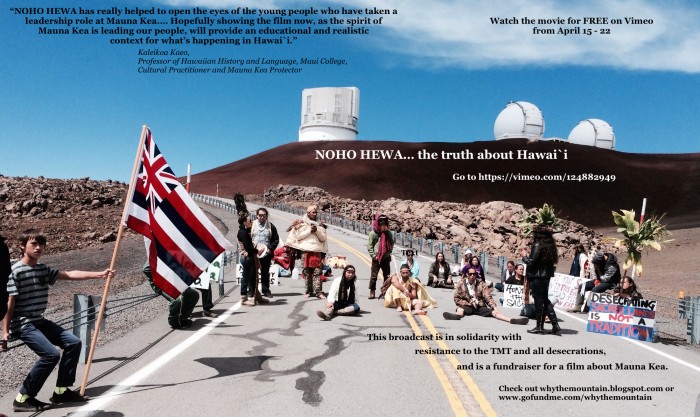
News Media Misses Real Story in Reporting on TMT Protest
The evidence debunking the fairy tale of Hawaii as the 50th State is conclusive but the news media ignores this.
 As a contributor who previously published this article in Civil Beat, Keokani Marciel has allowed this piece to be posted on this blog. He is a lifelong aloha ʻāina (Hawaiian patriot) and kanaka ʻōiwi (aboriginal Hawaiian) who holds a B.S. in Nutrition Science from the University of California at Davis, and an M.S. in Exercise Science from California University of Pennsylvania. In 2008, Keokani made a career change to mathematics education, and is currently studying to pass his second actuarial exam. With his background, he brings a quantitative and scientific emphasis to the discussion regarding the legal status of Hawaiʻi as an occupied nation-state. He has created the following link which lists the data and references used in this article goo.gl/d6Ra2B.
As a contributor who previously published this article in Civil Beat, Keokani Marciel has allowed this piece to be posted on this blog. He is a lifelong aloha ʻāina (Hawaiian patriot) and kanaka ʻōiwi (aboriginal Hawaiian) who holds a B.S. in Nutrition Science from the University of California at Davis, and an M.S. in Exercise Science from California University of Pennsylvania. In 2008, Keokani made a career change to mathematics education, and is currently studying to pass his second actuarial exam. With his background, he brings a quantitative and scientific emphasis to the discussion regarding the legal status of Hawaiʻi as an occupied nation-state. He has created the following link which lists the data and references used in this article goo.gl/d6Ra2B.
The largest newspaper in the occupied Hawaiian Kingdom marked the kickoff for the TMT blockade on March 26th with an online poll asking whether or not readers support the intervention. The final score at the end of this 24-hour poll was 53% in favor of the blockade and 47% against it. More than 4,600 votes were gathered by this self-selected survey. Although not a scientific poll, the sample size is significantly larger than average for this daily feature of the newspaper.
The arrest of 31 subjects and supporters of the Hawaiian Kingdom on April 2nd triggered international media attention. In the United States, most news organizations circulated the two reports from the Associated Press, both of which made sure to ommit the legal status of the Hawaiian Islands as a nation-state which remains under prolonged, illegal occupation since August 12, 1898. Consequently, most Americans remain under the mistaken impression that Hawaiʻi is annexed, as influenced by the systematic pasttime of Occupation denial and distortion uniformly practiced by corporate news media in the U.S. This phenomenon represents a deliberate refusal to look at the raw data regarding Hawaiian sovereignty, which has become common knowledge in the Occupied Kingdom.
Throughout its history, the United States has entered into a total of 9 treaties of cession over a period of 168 years (1783-1951). The first 6 of these 9 treaties annexed the territories from which all 49 states and Washington D.C. were admitted to the American Union, known as the United States, during the first 84 years of its history (1783-1867). The consistent adherence to this procedure by the U.S. represents customary international law. Furthermore, the two failed attempts to pass a treaty of cession in the U.S. Senate, in 1893 and 1897, clearly demonstrates the intent by the U.S. to maintain compliance with this international custom.
Hence, the joint resolution passed by U.S. Congress in 1898, used as a measure to seize Hawaiʻi during the Spanish-American War, was in violation of this self-evident pattern of customary international law. Consequently, Hawaiʻi came under U.S. occupation and not annexation. According to the laws of occupation, the U.S. was required to end its occupation of Hawaiʻi at the end of the Spanish-American War. Instead, the U.S. Occupation of Hawaiʻi, prolonged to the present day, is illegal. Additionally, it is the longest military occupation in modern history, which means there is no historical precedent to suggest that it is not near or passed its expiration date.
The feigned annexation of Hawaiʻi by joint resolution in 1898 was not the end of U.S. adherence to the customary international law of territorial annexation through bilateral treaty of cession. Merely 5 months after unilaterally seizing Hawaiʻi, the U.S. picked up where it left of by annexing Guam, Phillipines, and Puerto Rico through the 1898 Treaty of Paris. This was the 7th treaty of cession that the U.S. entered across a total of 115 years up to this point. The pattern continued such that the U.S. acquired a total of 6 territories by entering into 3 treaties of cession over a period of 61 years (1898-1951), following its seizure of Hawaiʻi by joint resolution.
American Sāmoa is the only other territory ever acquired by the U.S. through a joint resolution of U.S. Congress instead of a treaty of a cession ratified by at least two-thirds of the U.S. Senate. However, not for the same reason as Hawaiʻi. The Indian Appropriation Act of 1871 marked the end of treaties being entered into by the United States with Native American tribes. Furthermore, the Island of Palmas arbitration in 1925 established a legal precedent that a State can only enter into a treaty with another State, and not with a non-State tribal group. Since the territorial cessions of American Sāmoa to the United States, in 1900 and 1904, were by chiefs rather than States, this prevented the United States from using the treaty process reserved for the U.S. Senate. Consequently, a joint resolution of U.S. Congress was used to ratify these bilateral territorial cessions.
What makes Hawaiʻi different is that the U.S. Congress entered a joint resolution with a puppet government that it had installed in 1893, which did not have the consent of the people governed. Therefore, it was a unilateral seizure of territory by joint resolution, whereas the joint resolution annexing American Sāmoa was not due to an inability to obtain two-thirds approval of the U.S. Senate. In other words, American Sāmoa is legitimately annexed to the United States, albeit a non-self-governing territory according to the United Nations. This further isolates Hawaiʻi as the single historical anomaly of customary international law, unprecedented by comparison to the 57 states and territories legitimately ceded to the United States throughout its history.
The score bears repeating: 56 territories annexed by 9 treaties of cession, and the unique annexation of American Sāmoa, compared to Hawaiʻi being the lone territory seized by joint resolution—all in a span of 168 years. Hawaiʻi is chronologically sandwiched between 6 of these treaties of cession, along with the 50 territories they annexed prior to the Newlands Resolution, and the remaining 3 treaties of cession, along with the 6 territories they annexed plus American Sāmoa.
If one looks objectively at the raw data shown above, customary international law regarding territorial annexation by the United States becomes self-evident, and it logically follows that Hawaiʻi is occupied. However, alleged annexation of Hawaiʻi by congressional joint resolution is also in violation of the U.S. Constitution, which does not enumerate territorial annexation as a power of U.S. Congress. Instead, U.S. Congress only has the power to admit states from territory annexed by way of treaty, which in turn requires ratification by a supermajority of the U.S. Senate. Consequently, the Newlands Resolution of 1898, the Organic Act of 1900, and the Statehood Admission Act of 1959, are domestic laws that are constitutionally restricted to the borders of the entire 49 United States. Since occupation and annexation are mutually exclusive, Hawaiʻi is not inside of the United States. By analogy, hijacking an airplane does not transfer ownership title to the hijacker.
Additionally, 88 out of the 90 members of the U.S. Senate, of the 55th Congress, argued in 1898 that annexation of Hawaiʻi by joint resolution was unconstitutional (youtu.be/yC4v0k0wd0Y). Conversely, only two senators argued that annexation by joint resolution was constitutional. Therefore, for someone today to insist that the alleged annexation of Hawaiʻi by joint resolution is somehow constitutional, is to believe that 98% of the 55th U.S. Senate misinterpreted the U.S. Constitution in 1898, and therefore didn’t know what they were talking about.
When faced with the evidence, the world eventually accepted the reality that the Earth is spherical and that the planets in our solar system revolve around the sun. Likewise, now faced with the unequivocal evidence that Hawaiʻi is occupied and has never been annexed, people will have to let go of the longheld myth that Hawaiʻi is part of the United States. A nation-state taken over by another nation-state is either occupied or annexed, but cannot be both simultaneously. In summary, without a treaty of cession, Hawaiʻi is not annexed to the United States. Without annexation, Hawaiʻi was never admitted to the United States. Without admission, Hawaiʻi cannot be called a state of the United States. What you have instead in Hawaiʻi is an occupant government masquerading as a state.
The evidence debunking the fairy tale of Hawaiʻi as the “50th State” is so conclusive that it is logically only a matter of time before the paradigm shift completes its natural course. Furthermore, the cognitive dissonance that this involves is being accelerated on an unprecedented scale by the TMT standoff on Mauna Kea. Therefore, how much longer can the world continue looking the other way and pretend that Hawaiʻi is annexed—rather than occupied—by the United States? How much longer can the corporate news media—especially in the United States—continue this cover-up by omission?
KHON 2 News – State of Hawai‘i to Receive Millions in Lease Rent of 30-Meter Telescope
International Law “Forbids” Construction of the 30-meter Telescope
The position taken by Mauna Kea protectors that the building of the 30-meter telescope is a desecration of sacred land is firmly grounded in international law. Because the Hawaiian Kingdom has been under an illegal and prolonged occupation by the United States since the Spanish-American War in 1898, the international laws of occupation apply to Hawai‘i’s situation and not United States law.
International law prohibits a neutral country from being occupied when two or more other countries are at war with each other. In other words, the United States was prohibited from occupying the Hawaiian Kingdom, being an internationally recognized neutral country since 1854, in its war against Spain in 1898. Despite the violation of international law, the laws of occupation mandates the occupier to temporarily administer the laws of the occupied State until the occupation comes to an end.
During the Spanish-American War the laws of war and occupation of countries were considered customary international law and in 1899, The Hague Conventions codified these laws into four treaties. In 1907, The Hague Conventions were revised into fifteen treaties. The United States ratified all of the Hague Conventions. The 1907 Hague Convention, IV—Respecting the Laws and Customs of War on Land, applies to Hawai‘i’s occupation even if Hawai‘i is not a war with the United States.
Article 43 mandates the occupier “shall take all the measures in his power to restore, and ensure, as far as possible, public order and safety, while respecting, unless absolutely prevented, the laws in force in the country.” In addition, Article 56 specifically protects “institutions dedicated to religion, charity and education, [and] the arts and sciences. All seizure of, destruction or willful damage done to institutions of this character, historic monuments, works of art and science, is forbidden, and should be made the subject of legal proceedings.” The United States military considers violations of the provisions of the Hague Convention, IV, to be war crimes. Section 499 of the U.S. Army FM 27-10 states, “The term ‘war crime’ is the technical expression for a violation of the law of war by any person or persons, military or civilian. Every violation of the law of war is a war crime.”
The Mauna Kea protectors have generated worldwide awareness, much through social media, in order to prevent the building of a 30-meter telescope on the revered mountain in the Hawaiian Kingdom called Mauna Kea. Some are calling this the “Hawaiian Spring” that has similar traits to the “Arab Spring” where the younger generation in the Arab world was mobilized through social media to protest and demonstrate against undemocratic rule.
The developers of this would be 18-story telescope is TMT International Observatory (TIO) that was formed in 2014. Presently TIO is a partnership of six international organizations—the California Institute of Technology (USA), the National Institutes of Natural Science (Japan), the National Astronomical Observatories of the Chinese Academy of Science (China), the Regents of the University of California (USA), the Association of Canadian Universities for Research in Astronomy (Canada), and the Indian Institute of Astrophysics (India).
The proposed development began in 2010. According to the TMT website, “TMT completed an Environmental Impact Statement, after 14 community meetings, and it was signed by the Governor of Hawaii. The Cultural Impact Statement, as key part of the document, included consultations with Native Hawaiian cultural practitioners. No groups or individuals challenged the contents or process of this important and required document.”
TMT also stated that in 2013, “the Kahu Ku Mauna Council, made up of local Native Hawaiian cultural practitioners approved the University of Hawaii granting a sublease to TMT to build on Mauna Kea. The University of Hawaii Board of Regents, after another public hearing, agreed.” The following year, “the Hawaii Board of Land and Natural Resources voted to approve the sublease for the TMT site.”
Mauna Kea is government land of the Hawaiian Kingdom and in 1848 it came under the administration of the Minister of the Interior under An Act Relating to the Lands of His Majesty the King and of the Government. The Act states, “And we do hereby appoint the Minister of the Interior and his successors in office, to direct, superintend, and dispose of said lands, as provided in the Act to organize the Executive Departments… Provided, however, that the Minister of the Interior and his successors in office shall have the power, upon the approval of the King in Privy Council, to dispose of the government lands to Hawaiian subjects, upon such other terms and conditions as to him and the King in Privy Council, may seem best for the promotion of agriculture, and the best interests of the Hawaiian Kingdom.” By an Act in 1854, the Hawaiian Legislature allowed foreign nationals to own property in the Kingdom, but subject to Hawaiian law.
On October 18, 1893, a Presidential investigation concluded that the United States diplomat assigned to the Hawaiian Kingdom, John Stevens, and Naval Captain Gilbert Wiltse were directly responsible for the illegal overthrow of the Hawaiian Kingdom government that occurred on January 17, 1893. On December 18, President Cleveland entered into an executive agreement to reinstate Queen Lili‘uokalani and her cabinet but due to political wrangling in the Congress, Cleveland was not able carry out the agreement. What was on the minds of the Congress was to secure the Hawaiian Islands as a military outpost in order to protect the American west coast from foreign invasion.
Unable to secure a treaty of annexation, the United States Congress unilaterally seized the Hawaiian Islands during the Spanish-American War under what a Senator called a war necessity. The United States claim to sovereignty over the Hawaiian Islands relies on a congressional joint resolution of annexation that was signed into U.S. law by President McKinley on July 7, 1898. The underlying problem that congressmen at the time knew was that no law of Congress can have any force and effect beyond the borders of the United States. In other words, the United States could no more annex the Hawaiian Islands by passing a domestic law, than it could annex Canada today by passing a law. American diplomats and revisionist historians took measures to conceal this from the world. Today, the Hawaiian Islands serves as headquarters for the largest United States combatant unified command in the world called the U.S. Pacific Command, and 20% of the Hawaiian Islands come under the direct control of U.S. troops.
On January 17, 1893, U.S. forces seized the Hawaiian Kingdom government by illegally removing the Queen, as the chief executive officer, and her cabinet of ministers, and replaced them with insurgents. All other officials and employees in the executive and judicial branches of government were then forced to sign oaths of allegiance to the insurgents under threat by U.S. troops. This is called regime change.
The Hawaiian Kingdom government was renamed to the self-declared provisional government on January 17, 1893. On July 4, 1894, the same insurgents renamed themselves to be the Republic of Hawai‘i. By an Act of Congress on April 30, 1900, the so-called Republic of Hawai‘i was renamed the “Territory of Hawai‘i,” and by another Act of Congress on March 18, 1959, it was renamed the “State of Hawai‘i.” Interestingly, the Congress passed a joint resolution on November 23, 1993, apologizing for the illegal overthrow of the Hawaiian Kingdom government, and specifically called the Republic of Hawai‘i “self-declared.” Self-declared means it wasn’t a government a lawful government. So if the so-called Republic of Hawai‘i was self-declared, then its successors are self-declared as well since the so-called Territorial and State of Hawai‘i government can claim no U.S. authority if Congressional laws have no effect beyond U.S. borders.
Simply said, the Hawaiian Kingdom government was carjacked and merely painted red, white and blue.
In light of this important historical and legal information, TIO cannot claim to have a valid lease from the States of Hawai‘i to build the 30-meter telescope if the State of Hawai‘i is self-declared. Only a U.S. military governor established under the laws of occupation and temporarily acting in the capacity of the Hawaiian Kingdom’s Minister of the Interior could enter into a lease, but only after hearings and public input is gathered under Hawaiian Kingdom law and not the laws of the United States. The issue is not whether or not the 30-meter telescope should be built on Mauna Kea, but rather have Hawaiian laws been complied with that would allow or not allow the construction of the telescope. Should TIO disregard the law they would be prosecuted for war crimes.
Hawai‘i News Now – Hundreds rally against Thirty Meter Telescope at UH Manoa campus
UH Kapi‘olani Community College Student Walkout in Support of Mauna Kea Protectors
UH Hilo & UH Hawai‘i Community College Student Walkout in Support of Mauna Kea Protectors
 CORRECTION: The Student walkout at the University of Hawai‘i at Hilo and Hawai‘i Community College will take place at 12 noon, and not a 8:30. This is consistent with the Student walkouts at the University of Hawai‘i at Manoa, Kapi‘olani Community College, Windward Community College, and University of Hawai‘i Maui College.
CORRECTION: The Student walkout at the University of Hawai‘i at Hilo and Hawai‘i Community College will take place at 12 noon, and not a 8:30. This is consistent with the Student walkouts at the University of Hawai‘i at Manoa, Kapi‘olani Community College, Windward Community College, and University of Hawai‘i Maui College.
Press Release: Protectors of Mauna Kea Update Status
Mauna Kea, Kaʻohe, Hāmākua, Hawaiʻi
For Immediate Release
April 7, 2015
TMT SHUTDOWN
Protectors of Mauna Kea update the status of their encampment on the mountain
The protectors of Maunakea continue to camp out across the Maunakea Visitors Center at approximately 9,200 feet elevation night in and night out and will soon reach the two week mark of their encampment. Although over 30 arrests were made on Thursday, April 2 by the Hawaii County Police Department and the DOCARE officers of the DLNR, the protectors atop the mountain of Wākea, continue their stance against the construction of the Thirty Meter Telescope and continue to build momentum and gain support. One reason for the building of momentum and support, they say, is what they are calling the Kapu Aloha. “Abiding by this is what has fueled and protected us in this movement,” says Lanakila Mangauil. Mangauil says the Kapu Aloha is about conducting oneself with respect towards others, under any and all circumstances. Over the weekend, hundreds of supporters ascended the mountain to join in the protection efforts, with many flying in from Maui, Molokaʻi, Oʻahu and Kauaʻi. Although no construction has taken place since the day arrests were made, the protectors have kept a constant presence and plan to continue to do so while attempting to garner more support.
Protectors of the mountain have many reasons why they oppose the proposed construction of the TMT, one being that the mountain is considered sacred and perhaps the most sacred lands in all of Hawaiʻi. The mountain is named after Wākea who mated with Papahānaumoku to birth Hawaiʻi Island. The peak of the mountain is considered to be wao akua, or the realm of the gods, as it is the dwelling place of gods and goddesses such as Poliahu, Waiau, Lilinoe, Lihau, Kukahauula, Kahoupokane and Mooinanea. Another reason for the opposition to the TMT is the fact that protectors feel that the TMT does not adhere to the developmental laws of conservation lands as determined by the State of Hawaiʻi and the mountain also contains many religious shrines as well as burial sites and sits on top of the largest aquifer on the island of Hawaiʻi and therefore they consider it to be desecration. Lastly, the protectors realize and understand that even if the TMT was in compliance with the laws of developing on conservation lands, the State of Hawaiʻi is illegal and the Hawaiian Kingdom was never lawfully annexed by the United States of America and therefore continues to exits today according to International Law. This stems from the fact that Americaʻs only claim to annexing Hawaiʻi is by Joint Resolution on July 7, 1898, which is really just a domestic law having no authority outside the boundaries of its territory, and Hawaiʻi clearly was not a part of the U.S in 1898 since it required annexation. Because the State of Hawaiʻi is illegal, the protectors argue that every extension and branch of the State is therefore also illegal and due to this, all contracts between the contractors and the State of Hawaiʻi are void and illegal. Protectors of the mountain call upon all countries involved to honor the continued independence of Hawaiʻi that America has refused to acknowledge for the last 122 years while illegally occupying Hawaiʻi in violation of the laws of occupation.
The protectors of the mountain know that there are many out there who have and continue to offer their support through donations of food, water, money and other necessities, and while appreciated, those atop the mountain humbly and respectfully ask that any attempts of raising funds and collecting and delivering donations be communicated first with the protectors so as not to mismanage resources and cause confusion amongst the people in regards to what certain funds and donations could be used for. Kahoʻokahi Kanuha, one of the protectors and one who was arrested in the first group last Thursday, says “We canʻt thank everyone enough. The amount of support we have received over the past week is absolutely unbelievable and simply amazing. I am not quite sure our people have seen a movement like this in their lifetime and I think itʻs a testament to the fact that our people have been ignited and are ready to move forward and solidify ourselves once again throughout the world as a people and a country.”
###
For more information, contact:
1-808-494-0626 or 1-808-936-4249
tmtshutdown@gmail.com
Twitter: @tmtshutdown
#TMTshudown on Facebook, Instagram & Twitter
http://www.gofundme.com/

